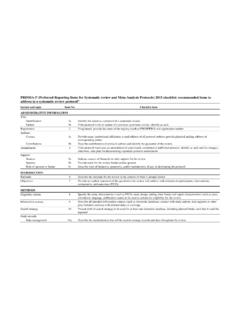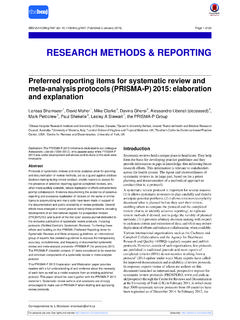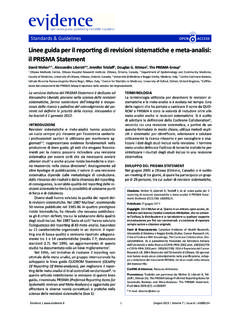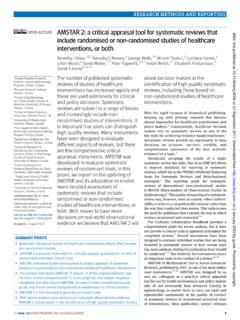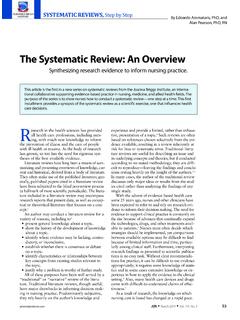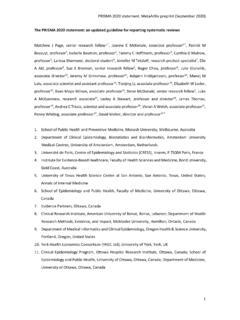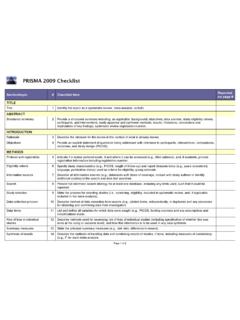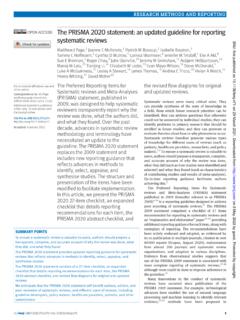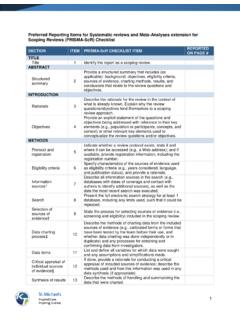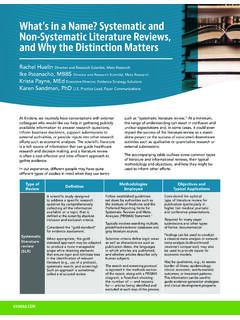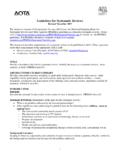Transcription of Preferred reporting items for systematic review and meta ...
1 RESEARCHOpen AccessPreferred reporting items for systematic reviewand meta-analysis protocols (PRISMA-P) 2015statementDavid Moher1*, Larissa Shamseer1, Mike Clarke2, Davina Ghersi3, Alessandro Liberati , Mark Petticrew4,Paul Shekelle5, Lesley A Stewart6and PRISMA-P GroupAbstractSystematic reviews should build on a protocol that describes the rationale, hypothesis, and planned methods of thereview; few reviews report whether a protocol exists. Detailed, well-described protocols can facilitate the understandingand appraisal of the review methods, as well as the detection of modifications to methods and selective reporting incompleted reviews. We describe the development of a reporting guideline, the Preferred reporting items forSystematic reviews and Meta-Analyses for Protocols 2015 (PRISMA-P 2015). PRISMA-P consists of a 17-item checklistintended to facilitate the preparation and reporting of a robust protocol for the systematic review . Funders and thosecommissioning reviews might consider mandating the use of the checklist to facilitate the submission of relevantprotocol information in funding applications.
2 Similarly, peer reviewers and editors can use the guidance to gauge thecompleteness and transparency of a systematic review protocol submitted for publication in a journal or reviews are the reference standard for syn-thesizing evidence in health care because of their meth-odological rigor. They are used to support thedevelopment of clinical practice guidelines and informclinical decision-making. They are becoming increas-ingly common; in 2010, 11 new reviews were estimatedto be published daily [1]. Ideally, systematic reviews arebased on pre-defined eligibility criteria and conductedaccording to a pre-defined methodological approach asoutlined in an associated preparation of a protocol is an essential compo-nent of the systematic review process; it ensures that asystematic review is carefully planned and that what isplanned is explicitly documented before the reviewstarts, thus promoting consistent conduct by the reviewteam, accountability, research integrity, and transparencyof the eventual completed review .
3 A protocol may alsoreduce arbitrariness in decision-making when extractingand using data from primary research, since planningprovides an opportunity for the review team to antici-pate potential problems. When clearly reported proto-cols are made available, they enable readers to identifydeviations from planned methods in completed reviewsand whether they bias the interpretation of a review re-sults and conclusions. Bias related to the selectivereporting of outcomes has been characterized as a ser-ious problem in clinical research, including systematicreviews [2-7].Until recently, systematic review protocols were gener-ally available only through select organizations, such asThe Cochrane [8] and Campbell Collaborations and theJoanna Briggs Institute, for which the preparation of aprotocol is mandatory. Outside of these organizations,the existence of a protocol is infrequently reported incompleted reviews [9,10]. Fewer than half of 300 system-atic reviews indexed on MEDLINE in November 2004(most recent generalizable sample; 2014 update under-way) report working from a protocol [10], 80% of whichare non-Cochrane affiliated.
4 Of the non-Cochrane thera-peutic reviews, only 11% mentioned the existence of aprotocol [10]. The majority of reviews in health care are* Deceased1 Ottawa Hospital Research Institute and University of Ottawa, Ottawa,CanadaFull list of author information is available at the end of the article 2015 Moher et al.; licensee BioMed Central. This is an Open Access article distributed under the terms of the CreativeCommons Attribution License ( ), which permits unrestricted use, distribution, andreproduction in any medium, provided the original work is properly credited. The Creative Commons Public DomainDedication waiver ( ) applies to the data made available in this article,unless otherwise al. systematic Reviews2015,4:1 and published outside of Cochrane, however[10]. The paucity of protocols may be due, in part, to theauthors lack of knowledge about how to write them andwhat to include. Currently, little succinct guidance isavailable for those preparing systematic review protocols,although the recent Standards for systematic Reviewsprepared by the Institute of Medicine (IOM) providesome guidance toward addressing this gap [11].
5 Many groups have called for the widespread preparationand registration of systematic review protocols in orderto increase the availability and accessibility ofapriorimethods for systematic reviews [12-14]. Such an effortmay reduce the duplication of effort [15] and reducethe publication bias of systematic reviews. This chal-lenge has been taken up by the Centre for Reviews andDissemination, University of York, which has spearheadedthe establishment of an international register PROS-PERO (International Prospective Register of OngoingSystematic Reviews, )[16,17]. The register, which enables the permanent docu-mentation of 22 mandatory (and 18 optional) items aboutthea prioridesign and conduct of a review , was launchedin February 2011. At the time of writing, >5,000 system-atic review protocols from over 70 countries have beenregistered since its inception. Starting in October 2013,new Cochrane protocols were and continue to be auto-matically added to with the improved accessibility of protocolsthrough registration comes the need for strengthenedtransparency, accuracy, and completeness of the reportsof protocols intended for dissemination.
6 A template toaid in the preparation of systematic review protocols,such as a reporting guideline, may help achieve this. Fur-thermore, such guidance will enable authors to create aclear and complete document of theira priorimethods,which may facilitate the registration of key informationinto the PROSPERO database. Building on an estab-lished guideline for systematic reviews and meta-analyses of studies evaluating health care interventions the Preferred reporting items for systematic reviewsand Meta-Analyses (PRISMA, ) [12,13] we have developed PRISMA for Protocols(PRISMA-P) 2014. Table 1 summarizes the differencein intentions between PRISMA-P and aim of PRISMA-P 2015 is to improve the qualityof systematic review protocols, similar to the impactachieved by other reporting guidelines [18-20]. By help-ing authors document ana prioriroad map of their sys-tematic review , PRISMA-P also has the potential toimprove the conduct of systematic reviews, as has beensuggested of other reporting guidelines [21].
7 This State-ment paper summarizes the development of the guide-line and presents the PRISMA-P is no standard definition for a systematic reviewand meta-analysis protocol, and we note that some ter-minology contained within these definitions may carrydifferent meanings for different readers ( , systematicsearch ). The terms systematic review , meta-analysis, and protocol are defined in Table 2. The former twoterms are in accordance with the definitions reported inthe PRISMA Statement [13] and are in line with thoseused by the Agency for Healthcare Research and Qual-ity s Evidence-based Practice Center (EPC) program [22],The Cochrane Collaboration [23], and the 2011 guidancefrom the Institute of Medicine [11]. The definition pro-vided is a culmination of the terminology used by theStandard Protocol items : Recommendations for Inter-ventional Trials (SPIRIT) 2013 initiative [24], the PROS-PERO register, and the IOM Standards (Table 2).ScopeThe PRISMA-P checklist is intended primarily for thepreparation of protocols of systematic reviews and meta-analyses that summarize aggregate data from studies,Table 1 PROSPERO and PRISMA-PDefinition and objectivePROSPERO: International ProspectiveRegister of systematic ReviewsAn online portal through which to register the intention to conduct a systematic review , with health-relatedoutcomes, before it is initiated [16].
8 One of the main goals of PROSPERO is to make the intent of systematicreviews known before they are conducted in order to reduce the unplanned duplication of systematicreviews [15]. In addition, by requiring the documentation ofa priorimethods, the register facilitatesincreased transparency in the review process by allowing readers of systematic reviews to comparemethods, outcomes, and analyses carried out with those planned in advance and judge whether suchchanges impact the results of a : Preferred reporting items forSystematic review and Meta-AnalysisProtocolsA guideline to help authors prepare protocols for planned systematic reviews and meta-analyses thatprovides them with a minimum set of items to be included in the protocol. A protocol is intended toprovide the rationale for the review and pre-planned methodological and analytic approach, prior toembarking on a review . Investigators should prepare a review protocol in advance of registering it inPROSPERO so that details requiring further consideration may be thought through in advance, avoidingthe need for multiple amendments to registration information.
9 PRISMA-P items have been derived largelyfrom the PRISMA checklist and items of the PROSPERO register, in order to facilitate seamless al. systematic Reviews2015,4:1 Page 2 of 9 the evaluations of the effects of interven-tions. There are many review types that are outside ofthis scope. As such, given the general lack of protocolguidance for other types of reviews, we encourage re-viewers preparing any type of review protocol to makeuse of PRISMA-P as applicable. Readers can also use thechecklist to assess the completeness of the reporting ofpublished protocols. However, it is not recommended touse the checklist as an assessment tool to gauge the ap-propriateness of the methods of a systematic reviewprotocol; it has not been validated for that of PRISMA-P 2015An international steering committee (MC, DG, AL, DM,MP, PS, and LAS) comprising members with wide-rangingexperience in systematic review methodology, protocolregistry development, and reporting guideline developmentled the development of PRISMA-P, coordinated by LS.
10 Theprocess proposed by the Enhancing the Quality and Trans-parency of Health Research (EQUATOR) Network wasused to guide PRISMA-P development [27]. The processhas 18 step-by-step recommendations grouped into fivemain stages:1. Initial steps (determine the need for a reportingguideline);2. Pre-meeting activities (identify contributors, conductDelphi exercise, generate a list of potential items ,and prepare for face-to-face meeting);3. Face-to-face consensus meeting (present results ofpre-meeting activities and relevant evidence);4. Post-meeting activities (develop guidance Statement,Explanation and Elaboration document, and apublication strategy);5. Post-publication activities (encourage uptake ofguideline).The first stage, Initial steps, was described above; de-tails of the remaining four steps are activitiesIn developing the PRISMA-P checklist, the steeringcommittee compiled a list of items from various toolsrelating to the preparation of systematic review proto-cols for discussion at a consensus meeting of , we mapped items from a Delphi exercisecarried out during the development of PROSPERO [28],PROSPERO register items , PRISMA checklist items [13],SPIRIT 2013 checklist items [29], and items of IOMS tandard [11] against each other to identify uniqueand overlapping concepts.
